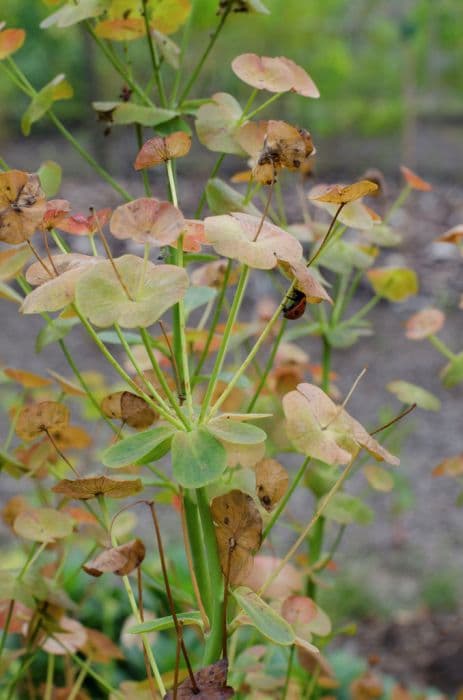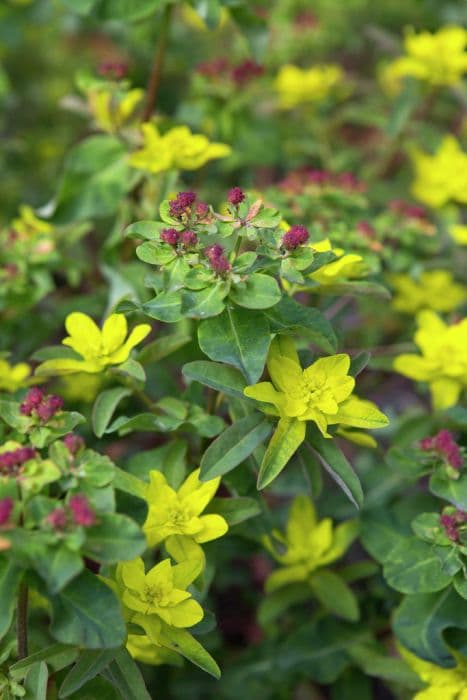Cypress Spurge Euphorbia cyparissias

ABOUT
commonly known as cypress spurge, is a perennial herb distinguished by its uniquely fine, needle-like foliage that is reminiscent of cypress trees. The leaves, set closely together on the stems, present a wispy, feathery look and are initially a bright green in color, transitioning to an eye-catching yellow or reddish hue in the fall. Its flowers aren't conspicuous in the traditional sense; rather, it has tiny, yellow-green structures, sometimes mistaken for petals, which are actually specialized leaves surrounding the true flowers. These tiny flowers add a subtle textural contrast to the foliage. The plant forms a dense, mat-like groundcover, and from spring to summer, it may produce a milky sap when cut or broken. This sap can be an irritant, a characteristic trait of this family of plants. Cypress spurge is known to be hardy, thriving in a variety of conditions, and can spread vigorously in favorable environments.
About this plant
 Names
NamesFamily
Euphorbiaceae
Synonyms
Cypress Spurge, Graveyard Moss, Cypress Euphorbia
Common names
Tithymalus cyparissias, Euphorbia cyparissias var. cyparissias, Euphorbia cyparissias var. microphylla, Euphorbia intercedens, Euphorbia lacerata, Euphorbia montana, Galarhoeus cyparissias, Tithymalus intercedens, Tithymalus montanus.
 Toxicity
ToxicityTo humans
Cypress spurge contains a toxic white latex in its sap that can cause skin irritation and inflammation upon contact. If ingested, it can lead to severe stomach pain, nausea, vomiting, and diarrhea. The toxins in this plant may also affect the nervous system and cause symptoms such as dizziness and lethargy. In severe cases, ingesting Cypress spurge can lead to more critical conditions like convulsions or coma. Contact with the eyes can result in temporary blindness and severe eye irritation. Handling this plant requires caution, and ingestion should be strictly avoided due to its toxic properties.
To pets
Cypress spurge is toxic to pets due to the presence of a milky sap containing irritant and toxic compounds. If pets consume any part of this plant, they can experience symptoms such as vomiting, diarrhea, drooling, and abdominal pain. The latex can also cause skin and eye irritation upon contact. More severe symptoms may include weakness, tremors, or seizures in extreme cases. Immediate veterinary care is crucial if a pet is suspected of ingesting Cypress spurge to mitigate the risk of serious consequences. It is important to prevent pets from accessing areas where this plant grows to ensure their safety.
 Characteristics
CharacteristicsLife cycle
Perennials
Foliage type
Deciduous
Color of leaves
Green
Flower color
Yellow
Height
1 feet (30 cm)
Spread
1 feet (30 cm)
Plant type
Herb
Hardiness zones
4
Native area
Europe
Benefits
 General Benefits
General Benefits- Drought Tolerance: Cypress spurge is highly resistant to drought, making it suitable for xeriscaping and low-water gardens.
- Erosion Control: Its dense mat-forming growth habit helps stabilize soil and prevent erosion on slopes.
- Low Maintenance: It requires minimal care once established, making it an easy choice for gardeners seeking low-maintenance plants.
- Rapid Growth: Cypress spurge grows quickly, providing fast ground cover and filling in garden spaces efficiently.
- Adaptable: It can thrive in a wide range of soil types, including poor and rocky soils.
- Attracts Pollinators: Its flowers can attract insects such as butterflies, providing ecological benefits.
- Deer Resistant: The plant has a degree of resistance to browsing by deer, which can protect other garden plants.
- Ornamental Appeal: Cypress spurge offers visual interest with its fine-textured foliage and yellow-green bracts that resemble flowers.
 Medical Properties
Medical Properties- Diuretic: Euphorbia cyparissias has been used traditionally for its diuretic properties to help increase the passing of urine.
- Laxative: The plant has been known to have laxative effects, which can help relieve constipation.
- Topical irritant: The sap is a strong irritant and has been historically applied to the skin to create blisters for the purpose of removing warts or treating other skin conditions.
- Expectorant: Traditional use also includes its role as an expectorant to help in the expulsion of phlegm from the airways.
 Air-purifying Qualities
Air-purifying QualitiesThis plant is not specifically known for air purifying qualities.
 Other Uses
Other Uses- Euphorbia cyparissias, commonly known as Cypress spurge, can be used for crafting natural insect repellents due to the toxic milky sap it produces that many insects avoid.
- The plant has been traditionally utilized as a protective barrier around gardens and crops, as its toxicity deters various animals and pests from encroaching on planted areas.
- Cypress spurge can be used in dye production, where the yellowish color of its cyathia (the specialized inflorescences of euphorbias) can imbue fabrics with a soft hue.
- Its distinct texture and drought resistance make Cypress spurge an excellent choice for xeriscaping and landscaping in arid regions, requiring little maintenance and water once established.
- The plant may be employed in ornamental dry flower arrangements; its ability to retain shape and color after drying makes it well suited for this purpose.
- Cypress spurge is sometimes used in model-making or dioramas, especially for creating miniature representations of grasses or heathland scenery.
- Due to its aggressive growth and dense matting habit, it can be planted on slopes or banks for soil erosion control, though it should be done cautiously due to its invasiveness.
- The sap of Cypress spurge can be carefully applied to remove warts; however, this should be done under expert guidance to avoid skin irritation or other issues.
- Educational use in botany can be another purpose, where Cypress spurge serves as an example plant to study the unique features of the Euphorbiaceae family, like its complex inflorescence and the latex-producing ability.
- Artists may use the latex from Cypress spurge as a medium in mixed-media art projects to create textures and layers, again taking care due to its toxic nature.
Interesting Facts
 Feng Shui
Feng ShuiThe Cypress Spurge is not used in Feng Shui practice.
 Zodiac Sign Compitability
Zodiac Sign CompitabilityThe Cypress Spurge is not used in astrology practice.
 Plant Symbolism
Plant Symbolism- Invincibility: Euphorbia cyparissias, commonly known as Cypress Spurge, has a toxic sap that deters herbivores, symbolizing an invincible or resilient nature.
- Protection: Given its toxic properties, the Cypress Spurge can represent a symbol of protection against enemies and negative energies.
- Persistence: Cypress Spurge can quickly colonize an area, symbolizing the trait of persistence or determination.
- Adaptation: As a plant that thrives in various conditions, it can symbolize the ability to adapt to diverse environments or situations.
 Water
WaterThe Cypress spurge should be watered deeply but infrequently, allowing the soil to dry out slightly between waterings. Generally, you can water the plant with approximately 1 gallon of water every week during the active growing season. Reduce the frequency of watering to every other week when the plant is dormant. Overwatering can lead to root rot, so it is important to ensure that the soil is well-draining. It's also beneficial to water the plant in the morning to allow any excess moisture on the foliage to evaporate throughout the day.
 Light
LightThe Cypress spurge thrives in full sun to partial shade. The best spot for this plant would be a location where it can receive at least 6 hours of direct sunlight daily. While it can tolerate partial shade, too much shade can lead to leggy growth and a decrease in the vibrancy of its foliage.
 Temperature
TemperatureCypress spurge is adaptable to a range of temperatures and can survive in conditions as low as 0 degrees Fahrenheit, but it will thrive in temperatures between 60 to 75 degrees Fahrenheit. To promote the best growth and vigor, ensure that the plant is situated in an area that avoids extreme cold or heat.
 Pruning
PruningPruning the Cypress spurge helps maintain its shape and encourages bushy growth. Prune lightly in the early spring just before new growth commences. Deadheading the spent flowers also promotes a tidier appearance and can help prevent unwanted self-seeding.
 Cleaning
CleaningAs needed
 Soil
SoilCypress spurge thrives in well-draining soil with a mix of sand, loam, and compost, at a pH range of 6.0 to 7.5.
 Repotting
RepottingCypress spurge does not typically need repotting; it is a perennial that grows well outdoors and can spread without frequent transplants.
 Humidity & Misting
Humidity & MistingCypress spurge is tolerant of a wide range of humidity levels, preferring dry to moderate conditions but does not require high humidity.
 Suitable locations
Suitable locationsIndoor
Provide full sun, minimal water, and avoid overcrowding.
Outdoor
Plant in full sun, well-draining soil; trim to prevent over-spreading.
Hardiness zone
4-8 USDA
 Life cycle
Life cycleEuphorbia cyparissias, commonly known as Cypress Spurge, is a perennial plant that begins its life cycle as seeds, which are dispersed by wind, water, or contact with animals. Upon finding favorable conditions, the seeds germinate in the spring, typically in well-drained soils with full or partial sunlight. The seedlings develop a deep taproot and grow into mature plants with slender stems and characteristic needle-like leaves. During the growing season, which is late spring to early summer, Cypress Spurge produces its yellow-green inflorescences, which contain numerous tiny flowers, attracting pollinators and aiding in its reproduction. After pollination, the plant develops capsules which burst open when ripe, spreading seeds for the next generation. The plant may also spread vegetatively through its extensive root system, enabling it to colonize large areas and become an aggressive invader in some regions.
 Propogation
PropogationPropogation time
Spring-Early Summer
The most popular method of propagating Cypress Spurge, or Euphorbia cyparissias, is by dividing the root system. This is typically done in the early spring or fall. To propagate by division, one should carefully dig up the established plant, ensuring a good portion of the root system with each section. It’s important to use a sharp shovel or knife to separate the roots into smaller clumps, each with several shoots and a healthy amount of roots. These divisions can then be replanted immediately at the same depth they were growing before, spaced about 8 to 12 inches (20 to 30 centimeters) apart, and watered thoroughly to establish them. Gloves should be worn during this process as the sap of Euphorbia cyparissias can be irritating to the skin and eyes.


![Spurge [Silver Swan]](/_next/image?url=https%3A%2F%2Fplants-admin.emdemapps.com%2Fimages%2Fplants%2F%2Fimages%2F604b573f6c8f6.png&w=640&q=75)






